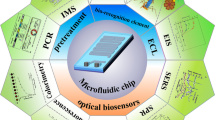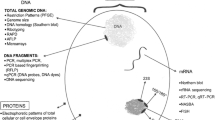Abstract
The presence of Burkholderia cepacia complex (BCC) strains has resulted in recalls of pharmaceutical products, since these opportunistic pathogens can cause serious infections. Rapid and sensitive diagnostic methods to detect BCC are crucial to determine contamination levels. We evaluated bacterial cultures, real-time PCR (qPCR), droplet digital PCR (ddPCR), and flow cytometry to detect BCC in nuclease-free water, in chlorhexidine gluconate (CHX) and benzalkonium chloride (BZK) solutions. Twenty BCC strains were each suspended (1, 10, 100, and 1000 CFU/ml) in autoclaved nuclease-free water, 10 μg/ml CHX, and 50 μg/ml BZK. Five replicates of each strain were tested at each concentration (20 strains × 4 concentrations × 5 replicates = 400 tests) to detect BCC using the aforementioned four methods. We demonstrated the potential of ddPCR and flow cytometry as more sensitive alternatives to culture-based methods to detect BCC in autoclaved nuclease-free water and antiseptics samples.


Similar content being viewed by others
References
Ahn Y, Kim JM, Ahn H, Lee YJ, LiPuma JJ, Hussong D, Cerniglia CE (2014) Evaluation of liquid and solid culture media for the recovery and enrichment of Burkholderia cenocepacia from distilled water. J Ind Microbiol Biotechnol 41:1109–1118. https://doi.org/10.1007/s10295-014-1442-3
Ahn Y, Kim JM, Kweon O, Kim SJ, Jones RC, Woodling K, Gamboa da Costa G, LiPuma JJ, Hussong D, Marasa BS, Cerniglia CE (2016) Intrinsic resistance of Burkholderia cepacia complex to benzalkonium chloride. MBio. https://doi.org/10.1128/mBio.01716-16
Ahn Y, Lee UJ, Lee YJ, LiPuma JJ, Hussong D, Marasa B, Cerniglia CE (2019) Oligotrophic media compared with a tryptic soy agar or broth for the recovery of Burkholderia cepacia complex from different storage temperatures and culture conditions. J Microbiol Biotechnol 29:1495–1505. https://doi.org/10.4014/jmb.1906.06024
Attia MA, Ali AE, Essam TM, Amin MA (2016) Direct detection of Burkholderia cepacia in susceptible pharmaceutical products using semi-nested PCR. PDA J Pharm Sci Technol 70:99–108. https://doi.org/10.5731/pdajpst.2015.006049
Becker SL, Berger FK, Feldner SK, Karliova I, Haber M, Mellmann A, Schafers HJ, Gartner B (2018) Outbreak of Burkholderia cepacia complex infections associated with contaminated octenidine mouthwash solution, Germany, August to September 2018. Euro Surveill. https://doi.org/10.2807/1560-7917.ES.2018.23.42.1800540
Buzatu DA, Cooper WM, Summage-West C, Sutherland JB, Williams AJ, Bass DA, Smith LL, Woodruff RS, Christman JM, Reid S, Tucker RK, Haney CJ, Ahmed A, Rafii F, Wilkes JG (2013) Photobleaching with phloxine B sensitizer to reduce food matrix interference for detection of Escherichia coli serotype O157:H7 in fresh spinach by flow cytometry. Food Microbiol 36:416–425. https://doi.org/10.1016/j.fm.2013.07.007
Carson LA, Favero MS, Bond WW, Petersen NJ (1973) Morphological, biochemical, and growth characteristics of Pseudomonas cepacia from distilled water. Appl Microbiol 25:476–483
CDC (2017) Multistate outbreak of Burkholderia cepacia bloodstream infections associated with contaminated prefilled saline flush syringes. Available from https://www.cdc.gov/hai/outbreaks/b-cepacia-saline-flush/index.html. Accessed 17 Jan 2020.
CDC (2017) Multistate outbreak of Burkholderia cepacia infections associated with oral liquid docusate sodium. Available from https://www.cdc.gov/hai/outbreaks/b-cepacia/ Accessed 17 Jan 2020.
CDC (2018) Multistate outbreak of Burkholderia cepacia complex infections associated with the use of medline remedy essentials no-rinse cleaning foam. Available from https://www.cdc.gov/hai/outbreaks/b-cepacia/no-rinse.html. Accessed 17 Jan 2020.
Cundell T (2019) Excluding Burkholderia cepacia complex from aqueous, non-sterile drug products. American Pharmaceutical Review Accesed 12 Feb 2019
Dedeckova K, Fila L, Skalicka V, Bartosova J, Kucerova T, Vavrova V, Zemkova D, Kalferstova L, Melter O, Cinek O, Drevinek P (2012) PCR detection of Burkholderia cepacia complex as one of key factors to handle a long-term outbreak. J Cyst Fibros 11:440–445. https://doi.org/10.1016/j.jcf.2012.04.005
Diehl F, Diaz LA Jr (2007) Digital quantification of mutant DNA in cancer patients. Curr Opin Oncol 19:36–42. https://doi.org/10.1097/CCO.0b013e328011a8e7
Dreo T, Pirc M, Ramsak Z, Pavsic J, Milavec M, Zel J, Gruden K (2014) Optimising droplet digital PCR analysis approaches for detection and quantification of bacteria: a case study of fire blight and potato brown rot. Anal Bioanal Chem 406:6513–6528. https://doi.org/10.1007/s00216-014-8084-1
Emslie KR, HM JL, Griffiths K, Forbes-Smith M, Pinheiro LB, Burke DG (2019) Droplet volume variability and impact on digital PCR copy number concentration measurements. Anal Chem 91:4124–4131. https://doi.org/10.1021/acs.analchem.8b05828
FDA (2017) FDA updates on 2017 Burkholderia cepacia contamination. Available from https://www.fda.gov/Drugs/DrugSafety/ucm570672.htm Accessed 17 Jan 2020.
Furlan JPR, Pitondo-Silva A, Braz VS, Gallo IFL, Stehling EG (2019) Evaluation of different molecular and phenotypic methods for identification of environmental Burkholderia cepacia complex. World J Microbiol Biotechnol 35:39. https://doi.org/10.1007/s11274-019-2614-0
Hindson CM, Chevillet JR, Briggs HA, Gallichotte EN, Ruf IK, Hindson BJ, Vessella RL, Tewari M (2013) Absolute quantification by droplet digital PCR versus analog real-time PCR. Nat Methods 10:1003–1005. https://doi.org/10.1038/nmeth.2633
Jimenez L (2007) Microbial diversity in pharmaceutical product recalls and environments. PDA J Pharm Sci Technol 61:383–399
Jimenez L, Jashari T, Vasquez J, Zapata S, Bochis J, Kulko M, Ellman V, Gardner M, Choe T (2018) Real-Time PCR detection of Burkholderia cepacia in pharmaceutical products contaminated with low levels of bacterial contamination. PDA J Pharm Sci Technol 72:73–80. https://doi.org/10.5731/pdajpst.2017.007971
Kim JM, Ahn Y, LiPuma JJ, Hussong D, Cerniglia CE (2015) Survival and susceptibility of Burkholderia cepacia complex in chlorhexidine gluconate and benzalkonium chloride. J Ind Microbiol Biotechnol 42:905–913. https://doi.org/10.1007/s10295-015-1605-x
LiPuma JJ, Dulaney BJ, McMenamin JD, Whitby PW, Stull TL, Coenye T, Vandamme P (1999) Development of rRNA-based PCR assays for identification of Burkholderia cepacia complex isolates recovered from cystic fibrosis patients. J Clin Microbiol 37:3167–3170
Mahenthiralingam E, Urban TA, Goldberg JB (2005) The multifarious, multireplicon Burkholderia cepacia complex. Nat Rev Microbiol 3:144–156. https://doi.org/10.1038/nrmicro1085
Marquez L, Jones KN, Whaley EM, Koy TH, Revell PA, Taylor RS, Bernhardt MB, Wagner JL, Dunn JJ, LiPuma JJ, Campbell JR (2017) An outbreak of Burkholderia cepacia complex infections associated with contaminated liquid docusate. Infect Control Hosp Epidemiol 38:567–573. https://doi.org/10.1017/ice.2017.11
Muller S, Nebe-von-Caron G (2010) Functional single-cell analyses: flow cytometry and cell sorting of microbial populations and communities. FEMS Microbiol Rev 34:554–587. https://doi.org/10.1111/j.1574-6976.2010.00214.x
Nshimyimana JP, Cruz MC, Wuertz S, Thompson JR (2019) Variably improved microbial source tracking with digital droplet PCR. Water Res 159:192–202. https://doi.org/10.1016/j.watres.2019.04.056
Peeters C, Daenekindt S, Vandamme P (2016) PCR detection of Burkholderia multivorans in water and soil samples. BMC Microbiol 16:184. https://doi.org/10.1186/s12866-016-0801-9
Pinheiro LB, Coleman VA, Hindson CM, Herrmann J, Hindson BJ, Bhat S, Emslie KR (2012) Evaluation of a droplet digital polymerase chain reaction format for DNA copy number quantification. Anal Chem 84:1003–1011. https://doi.org/10.1021/ac202578x
Pirone L, Chiarini L, Dalmastri C, Bevivino A, Tabacchioni S (2005) Detection of cultured and uncultured Burkholderia cepacia complex bacteria naturally occurring in the maize rhizosphere. Environ Microbiol 7:1734–1742. https://doi.org/10.1111/j.1462-2920.2005.00897.x
Pohl G, Shih Ie M (2004) Principle and applications of digital PCR. Expert Rev Mol Diagn 4:41–47
Salles JF, De Souza FA, van Elsas JD (2002) Molecular method to assess the diversity of Burkholderia species in environmental samples. Appl Environ Microbiol 68:1595–1603. https://doi.org/10.1128/aem.68.4.1595-1603.2002
Shelly DB, Spilker T, Gracely EJ, Coenye T, Vandamme P, LiPuma JJ (2000) Utility of commercial systems for identification of Burkholderia cepacia complex from cystic fibrosis sputum culture. J Clin Microbiol 38:3112–3115
Sutton S, Jimenez L (2012) A review of reported recalls involving microbiological control 2004–2011 with emphasis on FDA considerations of “objectionable organisms” American Pharmaceutical Review Accessed 1 Jan 2012
Torbeck LRD, Guilfoyle DE, Friedman RL, Hussong D (2011) Burkholderia cepacia: this decision is overdue. PDA J Pharm Sci and Technol 65:535–543
USP (2016) <61> Microbiological examination of nonsterile products - microbial enumeration tests. Available from https://hmc.usp.org/sites/default/files/documents/HMC/GCs-Pdfs/c61.pdf. Accessed 17 Jan 2020.
USP (2016) <1111> Microbiological examination of non-sterile products: acceptance criteria for pharmaceutical preparations and substances for pharmaceutical use. Available from https://www.usp.org/sites/default/files/usp/document/harmonization/gen-method/q05c_pf_ira_33_2_2007.pdf. Accessed 17 Jan 2020.
USP (2018) Pharmacopeial Forum 44(5), USP<60> Microbiological examination of nonsterile products-tests for Burkholderia cepacia complex. Available from https://www.uspnf.com/sites/default/files/usp_pdf/EN/USPNF/pf-44-5-toc-archive.pdf. Accessed 17 Jan 2020.
van Pelt C, Verduin CM, Goessens WH, Vos MC, Tummler B, Segonds C, Reubsaet F, Verbrugh H, van Belkum A (1999) Identification of Burkholderia spp. in the clinical microbiology laboratory: comparison of conventional and molecular methods. J Clin Microbiol 37:2158–2164
Vandamme P, Dawyndt P (2011) Classification and identification of the Burkholderia cepacia complex: past, present and future. Syst Appl Microbiol 34:87–95. https://doi.org/10.1016/j.syapm.2010.10.002
Vives-Rego J, Lebaron P, Nebe-von Caron G (2000) Current and future applications of flow cytometry in aquatic microbiology. FEMS Microbiol Rev 24:429–448. https://doi.org/10.1111/j.1574-6976.2000.tb00549.x
Vogelstein B, Kinzler KW (1999) Digital PCR. Proc Natl Acad Sci USA 96:9236–9241. https://doi.org/10.1073/pnas.96.16.9236
Whale AS, Cowen S, Foy CA, Huggett JF (2013) Methods for applying accurate digital PCR analysis on low copy DNA samples. PLoS ONE 8:e58177. https://doi.org/10.1371/journal.pone.0058177
Whitby PW, Dick HL, Campbell PW 3rd, Tullis DE, Matlow A, Stull TL (1998) Comparison of culture and PCR for detection of Burkholderia cepacia in sputum samples of patients with cystic fibrosis. J Clin Microbiol 36:1642–1645
Wilkes JG, Tucker RK, Montgomery JA, Cooper WM, Sutherland JB, Buzatu DA (2012) Reduction of food matrix interference by a combination of sample preparation and multi-dimensional gating techniques to facilitate rapid, high sensitivity analysis for Escherichia coli serotype O157 by flow cytometry. Food Microbiol 30:281–288. https://doi.org/10.1016/j.fm.2011.11.002
Williams AJ, Cooper WM, Ramsaroop S, Alusta P, Buzatu DA, Wilkes JG (2017) Rapid flow cytometry detection of a single viable Escherichia coli O157:H7 cell in raw spinach using a simplified sample preparation technique. Front Microbiol 8:1493. https://doi.org/10.3389/fmicb.2017.01493
Williams AJ, Cooper WM, Summage-West CV, Sims LM, Woodruff R, Christman J, Moskal TJ, Ramsaroop S, Sutherland JB, Alusta P, Wilkes JG, Buzatu DA (2015) Level 2 validation of a flow cytometric method for detection of Escherichia coli O157:H7 in raw spinach. Int J Food Microbiol 215:1–6. https://doi.org/10.1016/j.ijfoodmicro.2015.08.011
Xue Y, Wilkes JG, Moskal TJ, Williams AJ, Cooper WM, Nayak R, Rafii F, Buzatu DA (2016) Development of a flow cytometry-based method for rapid detection of Escherichia coli and Shigella Spp. using an oligonucleotide probe. PLoS ONE 11:e0150038. https://doi.org/10.1371/journal.pone.0150038
Acknowledgements
We thank Drs. Huizhong Chen and Kidon Sung for critical review of the manuscript. The views expressed herein do not necessarily reflect those of the U.S. Food and Drug Administration or the U.S. Department of Health and Human Services.
Author information
Authors and Affiliations
Corresponding author
Additional information
Publisher's Note
Springer Nature remains neutral with regard to jurisdictional claims in published maps and institutional affiliations.
Electronic supplementary material
Below is the link to the electronic supplementary material.
Rights and permissions
About this article
Cite this article
Ahn, Y., Gibson, B., Williams, A. et al. A comparison of culture-based, real-time PCR, droplet digital PCR and flow cytometric methods for the detection of Burkholderia cepacia complex in nuclease-free water and antiseptics. J Ind Microbiol Biotechnol 47, 475–484 (2020). https://doi.org/10.1007/s10295-020-02287-3
Received:
Accepted:
Published:
Issue Date:
DOI: https://doi.org/10.1007/s10295-020-02287-3




